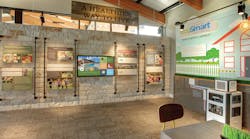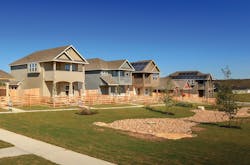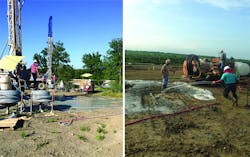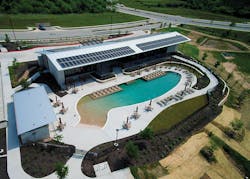Latest from Geothermal
Enertech Global Announces Brand Consolidation
Sponsored
The neatly trimmed boulevard that leads visitors into the 2,063-acre Whisper Valley planned community development east of Austin, Tex., meanders past immaculate newly built one- and two-story contemporary homes, a lush community vegetable garden, and a modernistic Discovery and Amenities Center with spacious offices and a fitness center overlooking a spectacular outdoor swimming pool.
At first glance, Whisper Valley looks like yet another new upscale housing development in a region where developers are working feverishly to build living spaces for the 150 new people who move every day to the Austin area for its booming economy.
But a closer look reveals its secret: Whisper Valley is part of a revolution – a revolution that its investors and builders predict will spread nationwide.
The 237 new homes near the entrance of Whisper Valley are the first of seven villages that will form a massive new planned community – eventually including 7,500 single-family and apartment homes and 2 million square feet of commercial space as well as schools, community buildings, and even its own waste water-treatment plant – with the potential to produce as much electricity as it uses.
It’s an entire, potential “net-zero energy user’’ city.
Trend Toward Sustainable Communities
The secret to Whisper Valley, its creators say, isn’t just new technology. It’s a new vision. The plan incorporates a host of advanced designs, technologies and a new development philosophy that, joined together, enable Whisper Valley’s homeowners to dramatically reduce their carbon footprints, live healthier lives and reduce their utility bills by as much as ten-fold.
But what makes this vision exciting – and likely to spread nationwide – is that these new technologies and lifestyle choices are being offered at affordable prices with homes starting under $250,000. And because the vision is affordable, it’s in high demand. “And because it’s in high demand, it’s proving profitable,” says Douglas Gilliland, managing partner of Taurus of Texas, which purchased the land a decade ago and has been designing and building its development vision ever since.
“This comprehensive approach to providing a healthy, sustainable, energy-efficient community is exactly what America needs and what consumers are demanding,” says Gilliland, whose company consists of U.S and German-based investors interested in taking an environmentally sustainable and economically responsible approach to development. “Our investors are getting an excellent return on their decision as well as the satisfaction of creating a community that will stand the test of time.”
“Investing in energy-efficient homes creates a huge and better return on investment for everyone involved,’’ adds Axel Lerche, founder and partner of EcoSmart Solution LLC, a business subsidiary of Taurus that designs, builds and operates Whisper Valley’s energy systems. “Sustainable investment requires sustainable technologies, and investing in energy-efficient infrastructure is an investment in sustainable development.’’
Solar Electric Meets Geo-exchange System
The vision for Whisper Valley is big. But it starts small.
Home footprints start at 1,100 square feet, smaller homes on smaller lots that allow Whisper Valley to exchange living space for open space. The vision includes 700 acres of open areas – more than a third of the land – for a 600-acre park, trails, fields and a link to a nearby wilderness county wildlife and recreation area.
But the foundation of Whisper Valley’s zero-energy-capable revolution lies six feet beneath the community’s perfectly laid-out streets.
It is a massive GeoGrid district geo-exchange system, commonly referred to as geothermal, already built into the ground that builders connect to in order to provide heating and cooling energy for each new home and building they construct.
Each home is equipped with a RAUGEO™ PEXa vertical ground loop and a highly efficient geothermal heat pump from either Bosch Thermotechnology or Enertech. RAUGEO is manufactured by REHAU, a global provider of PEX piping systems and a strategic partner in the Whisper Valley project. To take advantage of the earth’s 75-degree year-round temperatures in Austin, the RAUGEO ground loop is inserted into a 350-foot-deep borehole. Water passing through this pipe to the heat pump absorbs or emits heat energy depending on the season. With warm weather almost year-round in Austin, cooling is in high demand. Two 250-ton cooling towers are being used to augment the ground loop for heat rejection.
By using the earth’s energy to narrow the temperature gap, the heat pump produces perfectly conditioned indoor air with 65% less energy. The remaining 35% of the energy needed to power the pump is produced by each home’s rooftop solar panels -- from Canadian Solar and Fronius Inverter -- that also generate enough electricity to power computerized Nest temperature controls and highly efficient Bosch appliances. The homes are also connected to a first-of-its-kind community-wide Google superfast 1 GB Fiber network for entertainment, communication and living needs – including remote temperature controls.
But what makes Whisper Valley’s geothermal system truly innovative is that every REHAU ground loop is linked together with more than five miles of piping to form a unique GeoGrid that allows the entire system to share and optimize energy. The system is designed to exchange 720 tons of heat (an average of 3 tons per home). This GeoGrid technology breakthrough is a key factor in making Whisper Valley’s sustainable, zero- energy-capable homes affordable for homeowners.
With the GeoGrid infrastructure already installed, builders don’t have to set up independent geothermal systems for each home. Instead, they simply tap into the grid as they build. And because the grid’s miles of piping also captures vast amounts of energy from the earth, the number of vertical geothermal boreholes required for homes and buildings is also reduced.
“The result is geothermal energy that is even more affordable for homebuyers, who also enjoy significantly lower monthly bills,” says Lerche.
“We lived in an older, 700-square-foot rental home in downtown Austin where our last energy bill was $300 for the month – and that was keeping the temperature at 80 degrees,’’ says Paige Grossman, who moved to Whisper Valley in November with her husband, Mars Chapman. “We just got our first energy bill. It was $25 for our 1,400-square foot home, twice the living space, says Paige. “We’re very happy and a lot more comfortable.’’
Investors See Whisper Valley Concept Going Nationwide
While geothermal heat pumps aren’t new – already a feature in more than 2 million homes around the country – what is new and revolutionary is the scale and design of Whisper Valley, says Phil Schoen, president of Geo Enterprise Inc., a Tulsa-based company that installed the system.
“There are a few district geo-exchange systems out there. But there is nothing on the scale of Whisper Valley,’’ he says, noting that the system is highly efficient and seamless for homeowners to use. It provides steady, comfortable indoor temperatures while also removing the humidity, an important factor in the Austin area’s sultry hot summers.
“For most people, the single most important thing they can do to reduce their carbon footprint is the home they choose to live in,” adds Lerche. “If you can buy a more energy-efficient home that is smarter, with great Bosch appliances and great REHAU piping with low utility bills for a competitive price, why wouldn’t you? Our studies show most people – especially millennials – jump at the chance.”
“If we want to reduce our carbon footprint, geothermal is the future,” says Schoen, whose company has installed more than 25,000 systems around the world. “Geothermal is the lowest-cost heating and cooling system available today. Using a 3-ton equivalent geothermal system is the equivalent of saving an acre of trees or pulling two cars off the road for a year.”
Whisper Valley’s district GeoGrid is already performing 20 to 30 percent better than projected, and that’s with only 332,000 feet of RAUGEO vertical piping in place so far, Schoen adds. The system will gain efficiencies as it expands and the team works to wring out every possible Btu.
The picturesque swimming pool at the Amenities Center is already linked to the GeoGrid to act as a 58,000-gallon energy sink that can release or absorb energy as needed. The new water treatment plant will perform the same role, only on a much larger scale. A geothermal cooling tower is onsite to add to the capacity when severe temperatures occur. As new homes and buildings are built, thousands of new vertical ground loops, featuring millions of feet of RAUGEO PEXa piping, will be installed.
“We used REHAU PEXa double U-bend vertical loops because the system is well known in the industry with the most stress-resistant, flexible and strongest pipe,” Schoen says. “That’s critically important.”
Not only is the REHAU RAUGEO double U-bend durable and flexible enough to withstand harsh conditions, but it is also highly energy efficient. The PEXa double U-bend requires up to 30 percent less borehole footage to extract the same amount of energy as a single HDPE U-bend.
“REHAU is known in the geothermal industry as a very reliable partner, and we like strategic partnerships,’’ says Lerche. “We like companies who share a vision with us, who share a strategy, and who work together with us as a team – and REHAU is a great example.’’
“Because Whisper Valley’s unique GeoGrid, solar power and sustainable living concepts have found a home in the affordable housing market, this business model should open eyes around the country,” says Gilliland. “In almost every case, when we have a chance to meet homeowners, it’s as though they discovered something they didn’t think was out there.’’
“We know that geothermal heating and cooling will have a definite impact on our environment,’’ says Jenn Morton, who recently moved with her family to Whisper Valley. “Every individual makes a difference.’’
Morton says their previous utility bills topped $250 a month compared to $20 this April in Whisper Valley, while also providing daily teachable moments for their 8-year-old daughter.
The heat pump is located in their heavily insulated attic. Grossman notes that the system not only provides year-round comfortable temperatures; it is also extremely quiet, unlike their clunky outdoor condenser unit downtown that clicked on and off loudly and relentlessly all summer.
Terri Duncan, who considers her home at Whisper Valley her refuge for her upcoming retirement, adds that one of her favorite features of the EcoSmart energy system is that home energy use is controlled using Nest technology linked by a community-wide Google Fiber network. The easy-to-use system also allows homeowners to remotely control and monitor their energy use to further save energy.
“Being an engineer, I was amazed at how exceptionally well thought-out the entire system was, even before they started building. I love the feel of this place,” Terri says.
Whisper Valley’s success has made a deep impression on Taurus Investment – and the investors are already looking to the future, Gilliland says.
“We look at Whisper Valley as our greatest learning experience. Our biggest takeaway is that our concepts have been validated here. The next natural step is to move this concept across the country.’’





